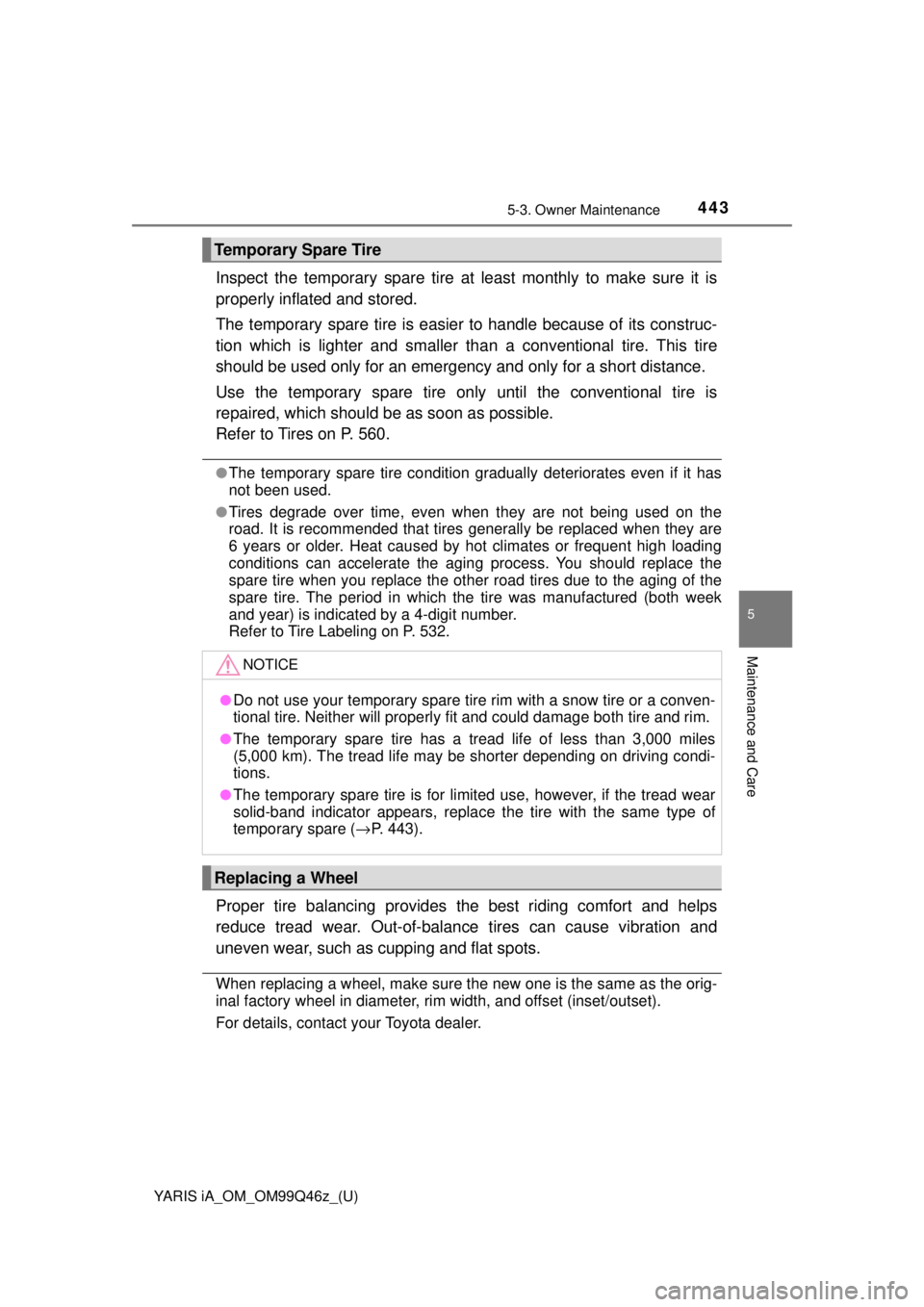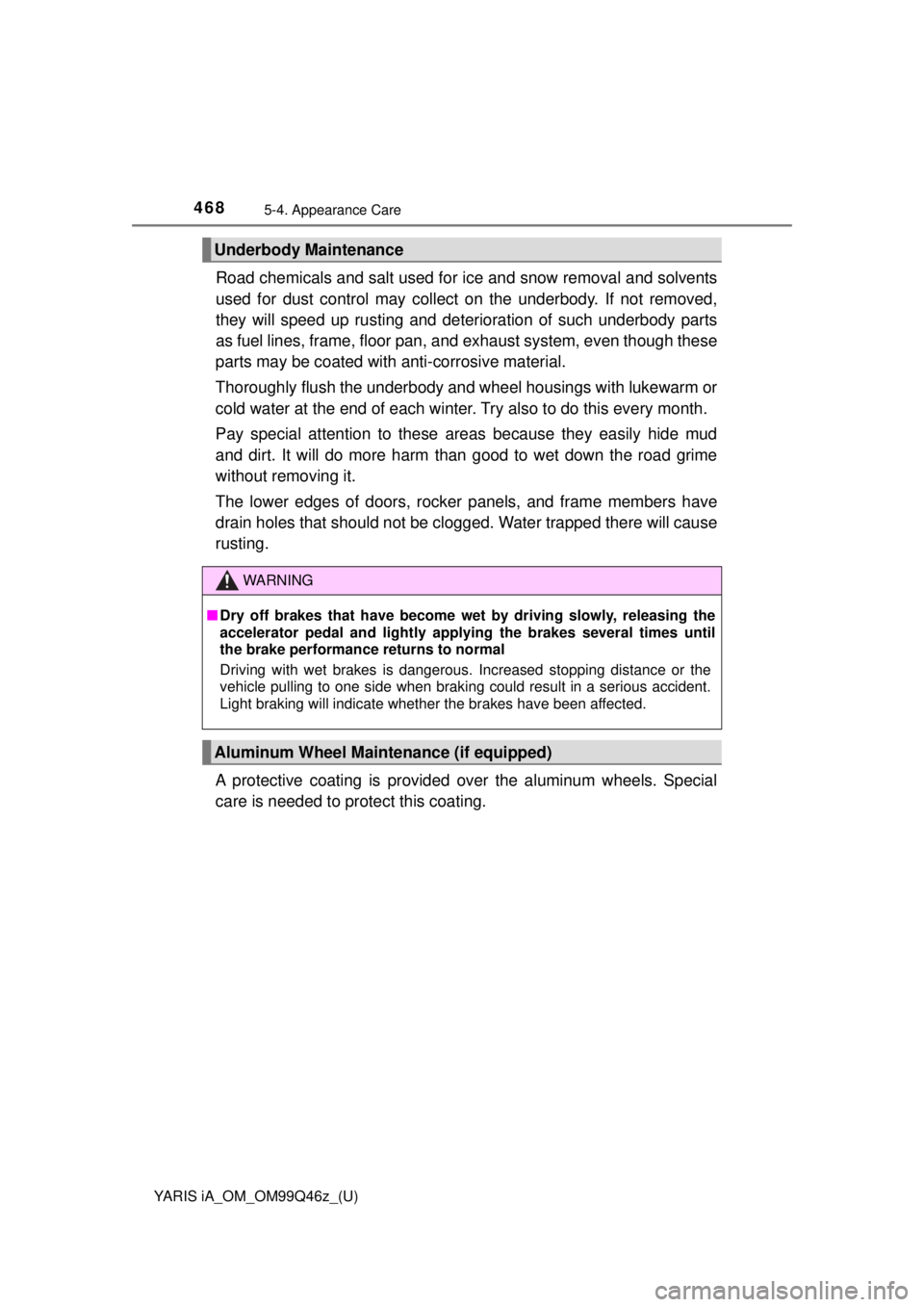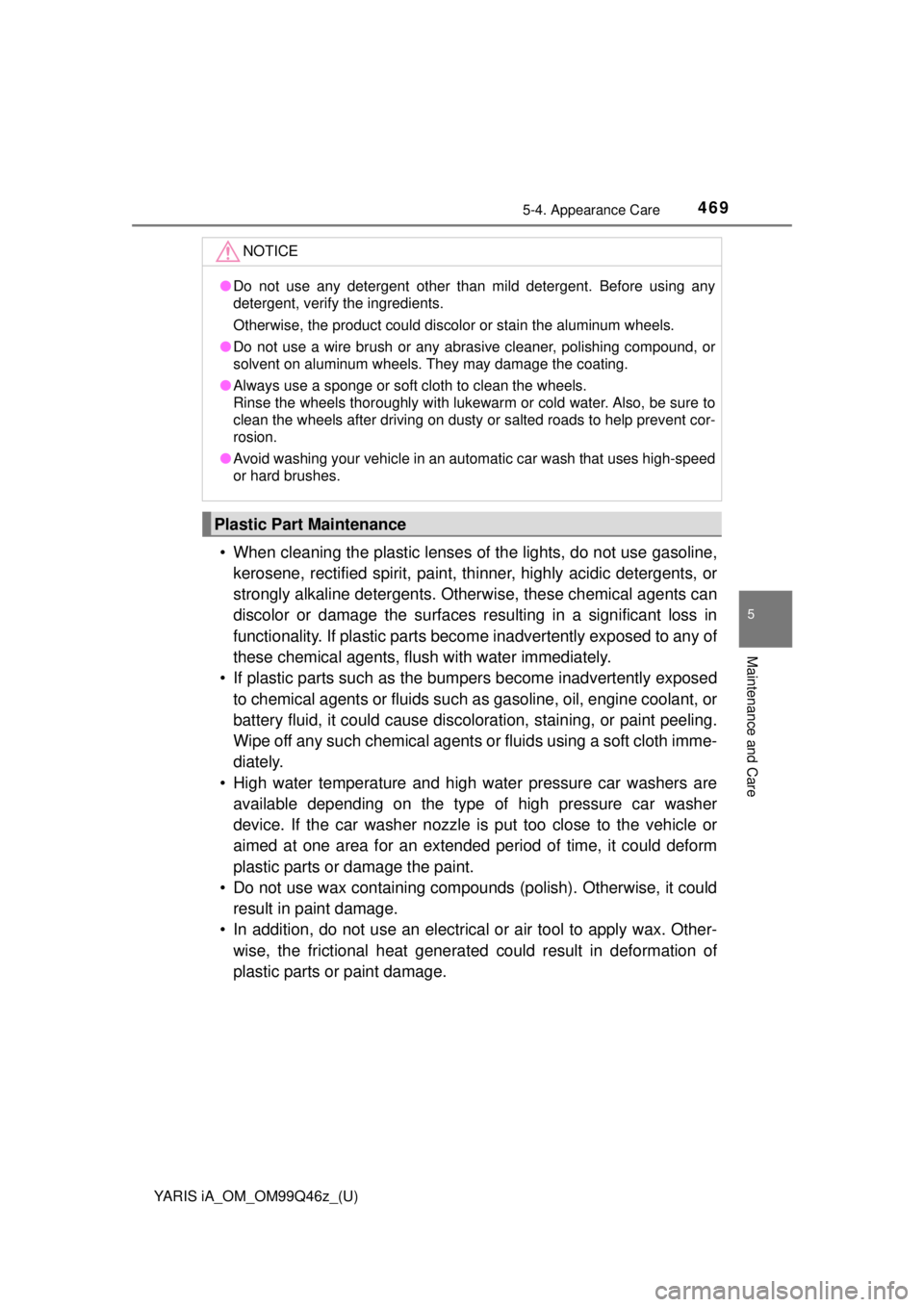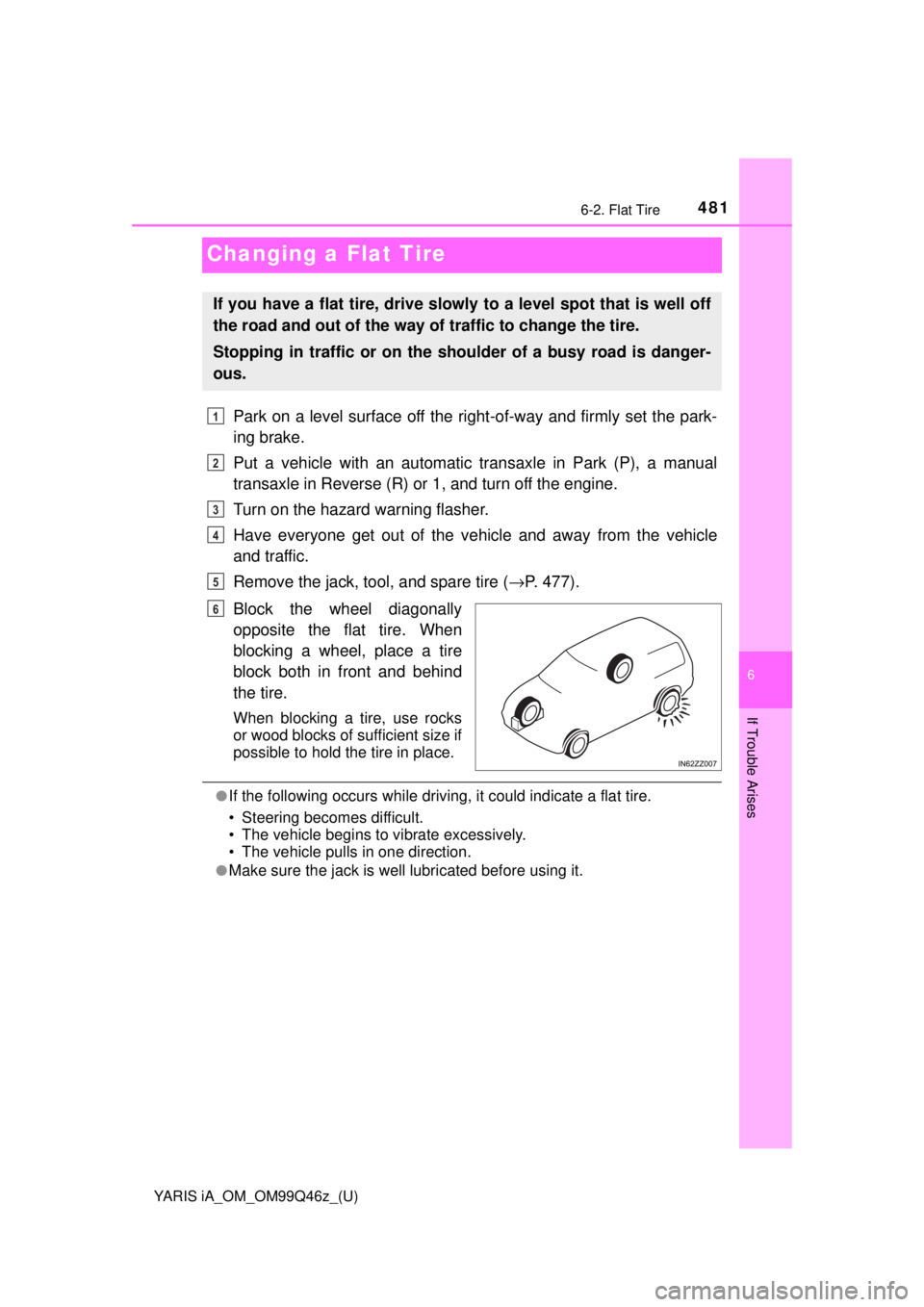Page 441 of 576

YARIS iA_OM_OM99Q46z_(U)
4415-3. Owner Maintenance
5
Maintenance and Care
Also, inspect them for uneven wear and damage. Abnormal wear is
usually caused by one or a combination of the following:• Incorrect tire pressure
• Improper wheel alignment
• Out-of-balance wheel
• Severe braking
After rotation, inflate all tire pressures to specification (
→P. 560) and
inspect the lug nu ts for tightness.
With tire pressure monitoring system:
After adjusting the tire pressure, init ialization of the tire pressure mon-
itoring system is necessary to make the system operate normally.
Refer to Tire Pressure Monitoring System Initialization on P. 221.
WARNING
■Rotate tires periodically
Irregular tire wear is dangerous. To equalize tire wear and extend tire
life, Toyota recommends that tire rotation is carried out at the same
interval as tire inspection.
For scheduled maintenance information, please refer to the “Owner’s
Manual Supplement/Scheduled Maintenance Guide”.
NOTICE
Rotate unidirectional tires and radial tires that have an asymmetrical
tread pattern or studs only from front to rear, not from side to side. Tire
performance will be reduced if rotated from side to side.
Page 443 of 576

YARIS iA_OM_OM99Q46z_(U)
4435-3. Owner Maintenance
5
Maintenance and Care
Inspect the temporary spare tire at least monthly to make sure it is
properly inflated and stored.
The temporary spare tire is easier to handle because of its construc-
tion which is lighter and smaller th an a conventional tire. This tire
should be used only for an emergen cy and only for a short distance.
Use the temporary spare tire on ly until the conventional tire is
repaired, which should be as soon as possible.
Refer to Tires on P. 560.
●The temporary spare tire condition gradually deteriorates even if it has
not been used.
●Tires degrade over time, even when they are not being used on the
road. It is recommended that tires gen erally be replaced when they are
6 years or older. Heat caused by ho t climates or frequent high loading
conditions can accelerate the aging process. You should replace the
spare tire when you replace the other road tires due to the aging of the
spare tire. The period in which the tire was manufactured (both week
and year) is indicated by a 4-digit number.
Refer to Tire Labeling on P. 532.
Proper tire balancing provides the best riding comfort and helps
reduce tread wear. Out-of-balance tires can cause vibration and
uneven wear, such as cupping and flat spots.
When replacing a wheel, make sure the new one is the same as the orig-
inal factory wheel in diameter, rim width, and offset (inset/outset).
For details, contact your Toyota dealer.
Temporary Spare Tire
NOTICE
●Do not use your temporary spare tire rim with a snow tire or a conven-
tional tire. Neither will properly fit and could damage both tire and rim.
●The temporary spare tire has a tread life of less than 3,000 miles
(5,000 km). The tread life may be shorter depending on driving condi-
tions.
●The temporary spare tire is for limited use, however, if the tread wear
solid-band indicator appears, replace the tire with the same type of
temporary spare (→ P. 443).
Replacing a Wheel
Page 444 of 576
4445-3. Owner Maintenance
YARIS iA_OM_OM99Q46z_(U)
WARNING
■Always use wheels of the correct size on your vehicle
Using a wrong-sized wheel is dangerous. Braking and handling could
be affected, leading to loss of control and an accident.
NOTICE
A wrong-sized wheel may adversely affect:
●Tire fit
●Wheel and bearing life
●Ground clearance
●Snow-chain clearance
●Speedometer calibration
●Headlight aim
●Bumper height
●Tire Pressure Monitoring System (if equipped)
Page 468 of 576

4685-4. Appearance Care
YARIS iA_OM_OM99Q46z_(U)
Road chemicals and salt used for ice and snow removal and solvents
used for dust control may collect on the underbody. If not removed,
they will speed up rusti ng and deterioration of such underbody parts
as fuel lines, frame, floor pan, a nd exhaust system, even though these
parts may be coated with anti-corrosive material.
Thoroughly flush the underbody and wheel housings with lukewarm or
cold water at the end of each winter. Try also to do this every month.
Pay special attention to these areas because they easily hide mud
and dirt. It will do more harm than good to wet down the road grime
without removing it.
The lower edges of doors, rocker panels, and frame members have
drain holes that should not be clogged. Water tr apped there will cause
rusting.
A protective coating is provided over the aluminum wheels. Special
care is needed to protect this coating.
Underbody Maintenance
WARNING
■ Dry off brakes that have become wet by driving slowly, releasing the
accelerator pedal and lightly applyi ng the brakes several times until
the brake performance returns to normal
Driving with wet brakes is dangerous. Increased stopping distance or the
vehicle pulling to one side when braking could result in a serious accident.
Light braking will indicate whether the brakes have been affected.
Aluminum Wheel Main tenance (if equipped)
Page 469 of 576

YARIS iA_OM_OM99Q46z_(U)
4695-4. Appearance Care
5
Maintenance and Care
• When cleaning the plastic lenses of the lights, do not use gasoline,
kerosene, rectified spirit , paint, thinner, highly acidic detergents, or
strongly alkaline detergents. Other wise, these chemical agents can
discolor or damage the surfaces resulting in a significant loss in
functionality. If plastic parts beco me inadvertently exposed to any of
these chemical age nts, flush with water immediately.
• If plastic parts such as the bu mpers become inadvertently exposed
to chemical agents or fluids such as gasoline, oil, engine coolant, or
battery fluid, it could cause discoloration, stai ning, or paint peeling.
Wipe off any such chemical agents or fluids using a soft cloth imme-
diately.
• High water temperature and high water pressure car washers are available depending on the type of high pressure car washer
device. If the car washer nozzle is put too close to the vehicle or
aimed at one area for an extended period of time, it could deform
plastic parts or damage the paint.
• Do not use wax containing compounds (polish). Otherwise, it could
result in paint damage.
• In addition, do not use an electrical or air tool to apply wax. Other-
wise, the frictional heat generat ed could result in deformation of
plastic parts or paint damage.
NOTICE
● Do not use any detergent other than mild detergent. Before using any
detergent, verify the ingredients.
Otherwise, the product could discolor or stain the aluminum wheels.
● Do not use a wire brush or any abrasive cleaner, polishing compound, or
solvent on aluminum wheels. They may damage the coating.
● Always use a sponge or soft cloth to clean the wheels.
Rinse the wheels thoroughly with lukewarm or cold water. Also, be sure to
clean the wheels after driving on dusty or salted roads to help prevent cor-
rosion.
● Avoid washing your vehicle in an automatic car wash that uses high-speed
or hard brushes.
Plastic Part Maintenance
Page 479 of 576

YARIS iA_OM_OM99Q46z_(U)
4796-2. Flat Tire
6
If Trouble Arises
Your Toyota has a temporary spare tire. The temporary spare tire is
lighter and smaller than a conventional tire, and is designed only for
emergency use and should be used only for VERY short periods.
Temporary spare tires should NEVER be used for long drives or
extended periods.
■To remove the spare tire
Lift the trunk mat.
Turn the spare tire hold-down
bolt counterclockwise.
■To secure the spare tire
Store the spare tire in the reverse order of removal. After storing,
verify that the spare tire is stored securely.
Spare Tire
1
Spare tire hold-down bolt2
WARNING
■Do not install the temporary spare tire on the front wheels (driving
wheels)
Driving with the temporary spare tire on one of the front driving wheels
is dangerous. Handling will be affected . You could lose control of the
vehicle, especially on ice or snow bound roads, and have an accident.
Move a regular tire to the front wheel and install the temporary spare tire
to the rear.
Page 481 of 576

481
YARIS iA_OM_OM99Q46z_(U)
6-2. Flat Tire
6
If Trouble Arises
Changing a Flat Tire
Park on a level surface off the right-of-way and firmly set the park-
ing brake.
Put a vehicle with an automatic transaxle in Park (P), a manual
transaxle in Reverse (R) or 1, and turn off the engine.
Turn on the hazard warning flasher.
Have everyone get out of the vehicle and away from the vehicle
and traffic.
Remove the jack, tool, and spare tire ( →P. 477).
Block the wheel diagonally
opposite the flat tire. When
blocking a wheel, place a tire
block both in front and behind
the tire.
When blocking a tire, use rocks
or wood blocks of sufficient size if
possible to hold the tire in place.
●If the following occurs wh ile driving, it could indicate a flat tire.
• Steering becomes difficult.
• The vehicle begins to vibrate excessively.
• The vehicle pulls in one direction.
●Make sure the jack is well lubricated before using it.
If you have a flat tire, drive slowly to a level spot that is well off
the road and out of the way of traffic to change the tire.
Stopping in traffic or on the shoulder of a busy road is danger-
ous.
1
2
3
4
5
6
Page 483 of 576
YARIS iA_OM_OM99Q46z_(U)
4836-2. Flat Tire
6
If Trouble Arises
If your vehicle is equipped with
a wheel cover, pry off the wheel
cover with the beveled end of
the jack lever.
Force the end of the jack lever
firmly between wheel and cover,
or removal will be difficult.
Loosen the lug nuts by turning
them counterclockwise one turn
each, but do not remove any
lug nuts until the tire has been
raised off the ground.
Place the jack on the ground.
Turn the jack screw in the direc-
tion shown in the figure and
adjust the jack head so that it is
close to the jack-up position.
Place the jack under the jack-
up position closest to the tire
being changed with the jack
head squarely under the jack-
up point.
Removing a Flat Tire
1
2
3
Jack head4
Jacking position
5